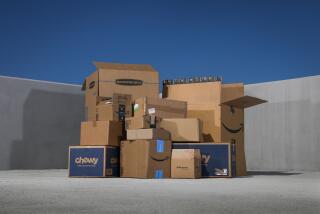The Cutting Edge: Computing / Technology / Innovation : From Six-Pack Packaging to New Homes : Recycling: Process allows Gridcore to convert trash into plywood-like substance.
- Share via
Jim Mahoney, design fabrication manager for Gridcore Systems International, recently took some six-pack containers and shredded newspapers and made a podium for his bosses.
On Tuesday in Long Beach, Gridcore President Robert Noble stood at that podium to dedicate a factory for the production of a new building panel called Gridcore, which is made entirely from consumer waste.
Gridcore says its new panels are inexpensive and environmentally safe, stronger and lighter than plywood--and sure to promote recycling efforts. They are being used in furniture, movie sets and stage displays, and Noble says they could fundamentally alter the way buildings are made.
“The future (for the panels) is in residential building construction,” Noble said. His company is spending $5 million over the next three years to develop Gridcore houses, in which everything, including the furniture and cabinets, will be made with Gridcore panels.
“The entire building will end up being less expensive than comparable building methods,” Noble said, and thus could eventually help provide families with adequate low-income housing.
The panels are made in a four-step process. First, old corrugated cardboard, six-pack containers, newsprint and wood waste are mixed with water in a 20-foot-high machine akin to a blender. This creates a pulp that is 99% water and 1% fiber.
A one-inch-thick layer of the pulp is then poured onto a 4-by-10-foot honeycomb mold, where the water is sucked out from underneath. This leaves a wet mat similar to that produced in paper making.
The mat is then pressed under intense heat to form hydrogen bonds between the fibers, which makes it stronger. One side of the mat is flat and the other side has sturdy ridges from the honeycomb mold.
Two of the 4-by-10 sheets are then glued together and pressed for 45 minutes with the ridges facing each other to further strengthen the panel, creating what looks like a honeycomb sandwich. The panel is then ready for manufacturing use, and can be painted and laminated just like wood, according to Mahoney.
Carlsbad, Calif.-based Gridcore has contracts with the Ikea furniture chain, Gap clothing stores and nearly 100 other companies. Noble said customers are enthusiastic about using a product that will reduce the amount of waste sent to landfills.
The panels, originally called “spaceboard,” were developed by the U.S. Agriculture Department’s Forest Products Laboratory, and Gridcore and two other companies bought the rights to the technology.
The Long Beach factory, which opened in April, is projected to reach full capacity in March and produce 10 times the amount of panels it is producing now, said David Saltman, Gridcore’s vice president of marketing and sales. There are already plans to expand the site, which now employs 21 people.
On Tuesday, Long Beach Mayor Beverly O’Neal, whose office pushed aggressively for Gridcore to build a factory there, was awarded a light-green key to the Gridcore world--one made of a panel produced from tattered paper currency supplied by the Federal Reserve System.
More to Read
Inside the business of entertainment
The Wide Shot brings you news, analysis and insights on everything from streaming wars to production — and what it all means for the future.
You may occasionally receive promotional content from the Los Angeles Times.










